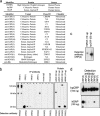Antibody-array interaction mapping, a new method to detect protein complexes applied to the discovery and study of serum amyloid P interactions with kininogen in human plasma
- PMID: 20023212
- PMCID: PMC2849714
- DOI: 10.1074/mcp.M900418-MCP200
Antibody-array interaction mapping, a new method to detect protein complexes applied to the discovery and study of serum amyloid P interactions with kininogen in human plasma
Abstract
Protein-protein interactions are fundamentally important in biological processes, but the existing analytical tools have limited ability to sensitively and precisely measure the dynamic composition of protein complexes in biological samples. We report here the development of antibody-array interaction mapping (AAIM) to address that need. We used AAIM to probe interactions among a set of 48 proteins in serum and found several known interactions as well potentially novel interactions, including multiprotein clusters of interactions. A novel interaction initially identified between the innate immune system protein C-reactive protein and the inflammatory protein kininogen (KNG) was confirmed in subsequent experiments to involve serum amyloid P instead of its highly related family member, C-reactive protein. AAIM was used in a variety of formats to further study this interaction. In vitro studies confirmed the ability of the purified proteins to interact and revealed a zinc dependence of the interaction. Studies using plasma samples collected longitudinally following a controlled myocardial infarction revealed no consistent changes in the serum amyloid P-KNG interaction levels but consistent changes in KNG activation and interactions with plasma prekallikrein. These results demonstrate a versatile platform for measuring the dynamic composition of protein complexes in biological samples that should have value for studies of normal and disease-related signaling networks, multiprotein clusters, or enzymatic cascades.
Figures





Similar articles
-
Identification of prekallikrein and high-molecular-weight kininogen as a complex in human plasma.Proc Natl Acad Sci U S A. 1976 Nov;73(11):4179-83. doi: 10.1073/pnas.73.11.4179. Proc Natl Acad Sci U S A. 1976. PMID: 1069308 Free PMC article.
-
Mapping of the prekallikrein-binding site of human H-kininogen by ligand screening of lambda gt11 expression libraries. Mimicking of the predicted binding site by anti-idiotypic antibodies.J Biol Chem. 1990 Jul 25;265(21):12494-502. J Biol Chem. 1990. PMID: 1695630
-
High molecular weight kininogen-binding site of prekallikrein probed by monoclonal antibodies.J Biol Chem. 1990 Jul 15;265(20):12005-11. J Biol Chem. 1990. PMID: 1694851
-
Array-based proteomic approaches to study signal transduction pathways: prospects, merits and challenges.Proteomics. 2015 Jan;15(2-3):218-31. doi: 10.1002/pmic.201400261. Epub 2014 Nov 2. Proteomics. 2015. PMID: 25266292 Review.
-
Quantitative functional analysis of protein complexes on surfaces.J Physiol. 2005 Feb 15;563(Pt 1):61-71. doi: 10.1113/jphysiol.2004.081117. Epub 2004 Dec 21. J Physiol. 2005. PMID: 15613368 Free PMC article. Review.
Cited by
-
Effects of berberine hydrochloride on immune response in the crab Charybdis japonica.BMC Genomics. 2022 Aug 11;23(1):578. doi: 10.1186/s12864-022-08798-w. BMC Genomics. 2022. PMID: 35953779 Free PMC article.
-
Increased Prolylcarboxypeptidase Expression Can Serve as a Biomarker of Senescence in Culture.Molecules. 2024 May 9;29(10):2219. doi: 10.3390/molecules29102219. Molecules. 2024. PMID: 38792081 Free PMC article.
-
The Marker State Space (MSS) method for classifying clinical samples.PLoS One. 2013 Jun 4;8(6):e65905. doi: 10.1371/journal.pone.0065905. Print 2013. PLoS One. 2013. PMID: 23750276 Free PMC article.
-
Antibody colocalization microarray: a scalable technology for multiplex protein analysis in complex samples.Mol Cell Proteomics. 2012 Apr;11(4):M111.011460. doi: 10.1074/mcp.M111.011460. Epub 2011 Dec 14. Mol Cell Proteomics. 2012. PMID: 22171321 Free PMC article.
-
Investigation of stable and transient protein-protein interactions: Past, present, and future.Proteomics. 2013 Feb;13(3-4):538-57. doi: 10.1002/pmic.201200328. Epub 2013 Jan 18. Proteomics. 2013. PMID: 23193082 Free PMC article. Review.
References
-
- Figeys D. (2008) Mapping the human protein interactome. Cell Res 18, 716–724 - PubMed
-
- Zhou D., He Y. (2008) Extracting interactions between proteins from the literature. J. Biomed. Inform 41, 393–407 - PubMed
-
- Chua H. N., Wong L. (2008) Increasing the reliability of protein interactomes. Drug Discov. Today 13, 652–658 - PubMed
-
- Zhu H., Snyder M. (2002) “Omic” approaches for unraveling signaling networks. Curr. Opin. Cell. Biol 14, 173–179 - PubMed
Publication types
MeSH terms
Substances
LinkOut - more resources
Full Text Sources
Research Materials
Miscellaneous

